Occupational environment monitoring of a bottled water manufacturing factory
99,000 ₫
Note: The above price is calculated for one sample, and the price may fluctuate depending on the area of the environment to be monitored and market movements. For more accurate pricing support, please refer to the price list or contact our consulting staff directly.
Monitoring the environment of a bottled water manufacturing factory is a session of collecting, analyzing, and evaluating factors at the workplace that may harm workers health.
Table of Contents
Toggle1. Overview of a Bottled Water Manufacturing Factory
a. What is a bottled water manufacturing factory?
A factory for bottled water manufacturing is an industrial facility designed and built to manufacture and bottle drinking water from natural spring sources. The goal of this factory is to provide high-quality and safe drinking water for consumers.
The factory selects reliable natural spring water sources and extracts water from them. The water is filtered and treated to remove impurities, bacteria, microorganisms, and other contaminants. Bottled water manufacturing factories typically comply with food safety and drinking water quality regulations to ensure that the final product is safe and meets international standards.

b. Production stages in a bottled water manufacturing factory
The production stages in a bottled water manufacturing factory may include the following steps:
- Water source extraction: The factory selects and extracts water from reliable natural springs. The water source is usually tested for safety and quality before use.
- Water treatment: Spring water is filtered and treated to remove impurities, bacteria, microorganisms, and other contaminants. Treatment may include filtration systems, ozonation, ultraviolet light, or chemical disinfection.
- Quality testing: Water samples are taken to ensure that the water meets safety and quality standards. Test parameters may include pH, hardness, mineral content, bacteria, and microorganisms.
- Refinement and balancing: Spring water may be refined and balanced to improve taste and ensure specific mineral content and stable pH.
- Bottling and packaging: Water is bottled or packaged after processing and quality testing. Bottles and packaging materials are food-safe and non-contaminating. Bottles are sealed, labeled, and prepared for distribution.
- Product inspection and storage: Before shipping, each batch is inspected to ensure quality and compliance with food safety regulations. Final products are stored under appropriate conditions to maintain quality and taste.

c. Machinery used in bottled water manufacturing factories
Bottled water manufacturing factories use various machinery and equipment to execute the manufacturing and bottling processes. Common machines include:
- Water filtration machines: These use different systems such as sand filters, carbon filters, microfiltration, or demineralization to remove impurities and contaminants.
- Ozone generators: Ozone generators disinfect water by producing ozone from oxygen in the air. Ozone kills bacteria, microorganisms, and eliminates odors.
- Demineralization machines: These remove excess minerals and salts, adjusting the water’s mineral content.
- Carbonation machines: Carbonation machines balance pH by adding carbonate, improving taste and water quality.
- Automatic bottling machines: These automate capping, filling, and bottling, with adjustable speed and quality control to meet standards.
- Label printing machines: These print brand information, ingredients, and other details on bottles or packaging.
- Packaging machines: These pack bottles into boxes or plastic wraps for protection and transport.
- Quality control machines: These test water parameters such as pH, hardness, mineral content, bacteria, and microorganisms.

d. Occupational diseases for workers in bottled water manufacturing factories
Workers in bottled water manufacturing factories may face health issues related to the work environment. Common occupational diseases include:
- Respiratory issues: Exposure to dust or vapors generated during water treatment can cause nasal inflammation, sinusitis, bronchitis, and other respiratory problems.
- Skin problems: Contact with chemicals used in water treatment may lead to dermatitis, skin irritation, eczema, and other skin conditions.
- Eye problems: Disinfectants and water treatment chemicals can cause eye irritation, conjunctivitis, and other eye issues.
- Hearing problems: Some raw materials and chemicals may damage hearing or cause other ear-related issues.
- Digestive issues: Accidental ingestion or hand contact with chemicals, combined with unsafe work practices, can lead to digestive toxicity and injuries.

2. Overview of Occupational Environment Monitoring Services
a. What is occupational environment monitoring in bottled water manufacturing factories?
Occupational environment monitoring (or workplace environment measurement) in bottled water manufacturing factories involves collecting, evaluating, and analyzing indicators of workplace environmental factors. This allows for timely interventions, minimizes environmental impacts on worker health, and prevents occupational diseases. Monitoring is mandatory for bottled water manufacturing factories.
Occupational environment monitoring plays a key role in protecting and enhancing worker health because employees are the primary resource and direct contributors to company profits. Workers frequently exposed to hazards beyond permissible limits are at risk of health issues and occupational diseases.
REGISTER FOR OCCUPATIONAL ENVIRONMENT MONITORING SERVICE
b. An Toan Nam Viet’s occupational environment monitoring program
An Toan Nam Viet’s occupational environment monitoring program is developed by monitoring engineers specializing in occupational safety and environmental protection. Aimed at ensuring worker health and safety, the program uses modern measurement techniques to monitor air quality, water, microclimate, physical factors, and dust in the workplace. This program is crucial for maintaining a safe working environment and protecting worker health.
Additionally, An Toan Nam Viet’s program is key in researching and developing new solutions to improve workplace environmental quality. With the dedication and professionalism of its monitoring experts, An Toan Nam Viet’s proprietary program represents a breakthrough in occupational safety and environmental management in Vietnam.

c. Standardization in workplace measurement procedures
Standardization in An Toan Nam Viet’s measurement procedures is crucial for ensuring accuracy and reliability. The program uses standards and procedures recognized by the Ho Chi Minh City Department of Health. This ensures that collected data is reliable for workplace assessments and for making decisions to improve working conditions and protect employee health.
Standardization also guarantees that measurements are conducted by highly qualified monitoring specialists with years of experience, giving managers and experts confidence in An Toan Nam Viet’s results for precise and valuable decision-making to protect worker health and the environment.
By applying standardized procedures, An Toan Nam Viet demonstrates its commitment to ensuring a safe work environment and protecting worker health, while also contributing to the development and enhancement of occupational safety and environmental management in Vietnam.
d. Reporting results of bottled water manufacturing factory monitoring
Monitoring results are compiled according to Form No. 04, Appendix III, issued with Decree 44/2016/ND-CP and prepared in 2 copies: 1 copy is sent to the enterprise that signed the monitoring contract, and 1 copy is retained by the monitoring organization.
According to legal regulations, monitoring records are stored indefinitely.

e. Frequency of occupational environment monitoring according to law
According to Clause 2, Article 18 of the Law on Occupational Safety and Hygiene 84/2015/QH13, employers must conduct occupational environment monitoring at least once a year to evaluate harmful factors.
f. Deadline for submitting monitoring reports according to law
The deadline is before December 31 each year. Enterprises must submit their occupational environment monitoring reports to the Department of Health in the locality where the business is headquartered and where employees work.
When there are changes in technology, manufacturing processes, or when upgrading facilities that may introduce new hazards, enterprises must update occupational hygiene records regarding harmful factors that require monitoring.
g. Penalties for violations of occupational environment monitoring for employers
According to Article 27 of Decree No. 12/2022/ND-CP dated January 17, 2022, on administrative penalties in labor, social insurance, and overseas employment contracts for Vietnamese workers:
- Clause 2: Fines from 2,000,000 – 5,000,000 VND for employers who fail to publicly inform employees at the monitoring site and management offices about results immediately after receiving monitoring results and hazard assessment outcomes.
- Clause 3: Fines from 20,000,000 – 40,000,000 VND for employers who fail to perform occupational environment monitoring to control health hazards as required by law.
- Clause 4: Fines from 40,000,000 – 60,000,000 VND for employers who collude with monitoring organizations to commit fraud in monitoring activities, without criminal liability.
3. Harmful Environmental Factors for Workers in Bottled Water Factories
In the working environment of a bottled water factory, there are several environmental factors that may be harmful to workers. Below are some potential harmful environmental factors in the bottled water production industry:
- Chemicals: The water treatment process may use chemicals such as ozone, antibacterial agents, or other water treatment substances. Exposure to these chemicals can cause skin, eye, respiratory, and digestive irritation, and in severe cases, may pose health risks.
- Dust and fumes: Bottled water production may generate dust and fumes from activities such as water treatment, bottling, and packaging. Inhaling these dusts and fumes can cause respiratory irritation, sinusitis, bronchitis, and other respiratory issues.
- Noise: Machinery and equipment in bottled water factories can produce high noise levels, especially during bottling and packaging processes. Continuous and excessive noise can affect hearing and cause stress for workers.
- Lighting: Some production processes may require strong or natural light. Workers exposed to intense or direct light may experience eye strain, irritation, and visual fatigue.
- Temperature and humidity: Certain processes in bottled water factories may create environments with high temperature and humidity. Uncomfortable working conditions can cause discomfort and affect workers’ health and performance.

REGISTER FOR WORKPLACE ENVIRONMENT MONITORING SERVICE
4. Measures to Improve Working Conditions in Bottled Water Factories
Improving working conditions in bottled water factories is crucial for protecting health and ensuring safety for workers. The following measures can be applied:
- Ensure good ventilation: Provide an effective ventilation system to remove dust, fumes, and harmful substances from the workspace. This helps reduce the risk of inhaling hazardous materials and improves air circulation.
- Use protective equipment: Ensure that workers are provided with adequate personal protective equipment such as masks, safety goggles, gloves, protective clothing, and earplugs. This helps protect them from direct exposure to harmful substances and reduces environmental impact.
- Ensure electrical safety: Regularly inspect and maintain electrical systems, use safe electrical equipment, and ensure a stable power supply. This prevents electrical accidents and reduces the risk of fire or explosion.
- Employee training and education: Provide training on occupational safety and health. This includes information on hazardous substances in the bottled water production process, instructions on using protective equipment, and guidance for emergency situations.
- Implement safe work procedures: Ensure adherence to safe work procedures and instructions for operating machinery and equipment. This minimizes the risk of accidents and protects workers’ health.
- Periodically conduct workplace environment monitoring in factories, collect and analyze harmful factors for workers, and adjust measures to reduce hazards and prevent occupational diseases.
5. Benefits of Periodic Monitoring in Bottled Water Factories
An Toan Nam Viet provides enterprises with excellent benefits when using workplace environment monitoring services in accordance with Decree 44/2016/ND-CP on the management and control of harmful factors in working environments affecting workers.
- Enterprises can proactively control harmful factors in their workshops or factories.
- Receive recommendations for measures to reduce harmful factors and improve the quality of the working environment.
- Indirectly protect human resources, the main factor in enterprise development.
- Minimize the impact of occupational diseases on workers’ health, thereby reducing future treatment costs.
- Improved worker health leads to higher product quality and ensures production output.
- Comply with labor safety regulations and avoid legal risks.
- Enhance professionalism and reputation, thereby elevating the enterprise’s brand.
Nam Viet’s environmental monitoring service is a solution to reduce occupational disease risks, contributing to a clean and high-quality working environment.

6. Nationwide Workplace Environment Monitoring Center
Nam Viet Workplace Environment Monitoring Center is a professional unit specializing in monitoring and measuring workplace environmental quality throughout all provinces of Vietnam. With an experienced team of monitoring specialists, the center uses modern measuring equipment to ensure accuracy and reliability.
In addition to monitoring services, the center assists clients in planning, handling, and tracking workplace environmental issues. Following the motto “customer-centric,” the center prioritizes client satisfaction, meets all needs, and provides the best solutions for businesses.
REGISTER FOR WORKPLACE ENVIRONMENT MONITORING SERVICE
With investment in technology, equipment, and personnel, Nam Viet’s monitoring center has become a reputable unit in the field of workplace environment monitoring in Ho Chi Minh City, with goals including:
- We always prioritize brand reputation and service quality.
- We provide clients with the best and most suitable solutions.
- Alongside a team of experienced Masters and Engineers aiming to protect the environment and benefit businesses.
- By working with Nam Viet Environmental Monitoring, companies receive professional service from experts in the field, along with the best cost advantages.
The workplace environment monitoring process at Nam Viet includes:
- Before monitoring, all machinery and equipment are calibrated according to legal regulations.
- Implement the full monitoring process as committed to the Department of Health.
- Report monitoring results honestly to employers.
- If monitoring results indicate unsafe conditions, Nam Viet will provide solutions, and the enterprise will implement the following:
- Implement measures to improve working conditions, minimize harmful factor impacts, and prevent occupational diseases.
- Organize health check-ups to detect occupational and work-related diseases early for employees in unsafe environments.
- Provide in-kind benefits to employees according to labor laws.

7. Workplace Environment Monitoring Service Price List
To help businesses perform workplace environment monitoring professionally and effectively, Nam Viet provides clients with a quality and reasonably priced service price list.
- Our price list provides detailed information on the costs of the monitoring services we offer, including transportation, measurement, analysis, and reporting. Clients can trust the accuracy and reliability of our reports.
- We commit to providing the most competitive and reasonable prices in the market and are always ready to answer questions about monitoring services quickly and professionally.
- With Nam Viet’s price list, clients can easily choose service packages that meet their needs. We are committed to delivering the highest satisfaction with professional service quality.
No comments yet

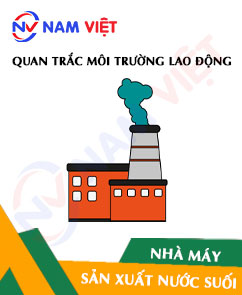
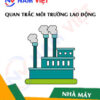
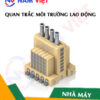

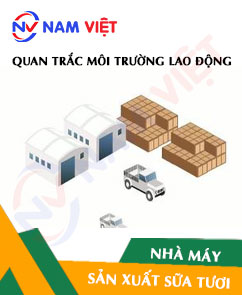

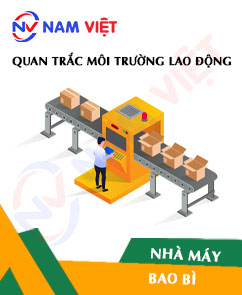

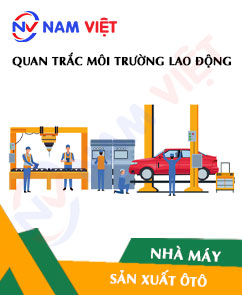


Review Occupational environment monitoring of a bottled water manufacturing factory
There are no reviews yet.